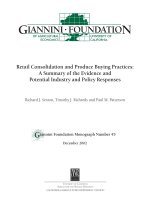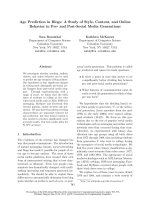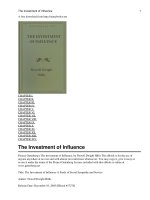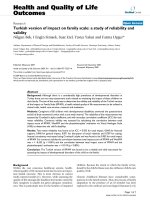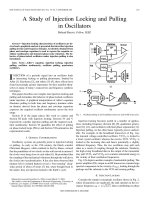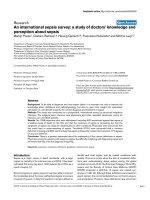Factors affecting customer satisfaction on retailers website a study of vietnam electronics and appliances industry
Bạn đang xem bản rút gọn của tài liệu. Xem và tải ngay bản đầy đủ của tài liệu tại đây (1.55 MB, 79 trang )
UNIVERSITY OF ECONOMICS HO CHI MINH CITY
International School of Business
-----------------------------Đinh Thiên Phúc
FACTORS AFFECTING CUSTOMER SATISFACTION ON
RETAILER’S WEBSITE: A STUDY OF VIETNAM ELECTRONICS AND
APPLIANCES INDUSTRY
MASTER OF BUSINESS (Honours)
HO CHI MINH City - Year 2015
UNIVERSITY OF ECONOMICS HO CHI MINH CITY
International School of Business
-----------------------------Đinh Thiên Phúc
FACTORS AFFECTING CUSTOMER SATISFACTION ON
RETAILER’S WEBSITE: A STUDY OF VIETNAM ELECTRONICS AND
APPLIANCES INDUSTRY
ID: 22120097
MASTER OF BUSINESS (Honours)
SUPERVISOR: Dr. PHAM NGOC THUY
HO CHI MINH City - Year 2015
i
ABSTRACT
Vietnam ranks 18/20 countries with the largest number of Internet users in the world,
ranking eighth Asia and ranks third in Southeast Asia. Online shopping is the strategic
direction in 2015 of electronics and appliances retail industry. This research aims to identify
the influence of the website elements to customer satisfaction on electronics and appliances
retailers’ websites. This research will find out that specific information, care taking, general
information, billing and payment are 4 factors that affecting customer satisfaction with
specific information is the most important factor.
Keywords: customer satisfaction, electronics and appliances, retailers’ website,
online shopping
ii
TABLE OF CONTENTS
ABSTRACT.........................................................................................................................i
TABLE OF CONTENTS ...................................................................................................ii
LIST OF FIGURES .......................................................................................................... iv
LIST OF TABLES ............................................................................................................. v
CHAPTER 1: INTRODUCTION ...................................................................................... 1
1.1.
Research Background .................................................................................................1
1.2.
Research Problems ......................................................................................................5
1.3.
Research Objectives ....................................................................................................7
1.4.
Research Significance .................................................................................................7
1.5.
Research Scope ...........................................................................................................7
CHAPTER 2: LITERATURE REVIEW .......................................................................... 9
2.1.
Theoritical Background ..............................................................................................9
2.2.
Customer satisfaction................................................................................................10
2.3.
Factors affecting customer satisfaction on retailers’ website ...................................10
2.3.1. Website elements related to information influence on customer satisfaction .......11
2.3.2. Website elements related to service influence on customer satisfaction ..............13
2.3.3. Website elements related to system influence on customer satisfaction...............14
2.4.
Research Model ........................................................................................................15
2.5.
Summary ...................................................................................................................16
CHAPTER 3: RESEARCH METHODOLOGY ............................................................ 17
3.1.
Research Process ......................................................................................................17
3.2.
Research sampling method .......................................................................................19
3.3.
Measures of the constructs........................................................................................20
3.4.
Data collection procedure .........................................................................................23
3.5.
Data analysis method ................................................................................................24
iii
3.5.1. Descriptive analysis ...............................................................................................24
3.5.2. Reliability analysis ................................................................................................24
3.5.3. Exploratory Factor Analysis (EFA) ......................................................................25
3.5.4. Multiple regression analysis ..................................................................................25
3.5.5. Summary ...............................................................................................................25
CHAPTER 4: RESULTS AND ANALYSIS ................................................................... 27
4.1.
Sample description ....................................................................................................27
4.2.
Cronbach’s alpha test ................................................................................................28
4.3.
Exploratory Factor Analysis (EFA) ..........................................................................31
4.4.
Pearson Correlation Coefficient ...............................................................................38
4.5.
Hypotheses testing ....................................................................................................39
4.6.
Discussions of the findings .......................................................................................44
4.7.
Sumarry.....................................................................................................................46
CHAPTER 5: CONCLUSION AND IMPLICATIONS ................................................. 48
5.1.
Conclusion ................................................................................................................48
5.2.
Implications of this research .....................................................................................50
5.3.
Research limitations and implications for future research .......................................51
REFERENCES ................................................................................................................. 53
APPENDIX A – QUESTIONNAIRE IN ENGLISH ...................................................... 58
APPENDIX B – QUESTIONNAIRE IN VIETNAMESE .............................................. 62
APPENDIX C – STATISTIC ANALYSIS RESULTS ................................................... 66
APPENDIX D – MULTIPLE LINEAR REGRESSION ................................................ 69
APPENDIX E – PILOT STUDY RESULTS................................................................... 70
iv
LIST OF FIGURES
Figure 1.1. Step 1. Searching .................................................................................... 3
Figure 1.2. Step 2. Finding Information ................................................................... 3
Figure 1.3. Step 3. Order Taking .............................................................................. 4
Figure 1.4. Step 4. Payment ...................................................................................... 5
Figure 1.5. Step 5. Confirmation .............................................................................. 5
Figure 2.1. The proposed research model .............................................................. 15
Figure 3.1. Research Process .................................................................................. 18
Figure D.1. Histogram of SATIS dependent variable ............................................ 69
Figure D.2. Normal P-P Plot of regression standardized residual ......................... 69
v
LIST OF TABLES
Tables 3.1. Measurement scales 1 .......................................................................... 20
Tables 3.2. Measurement scales 2 .......................................................................... 23
Table 4.0. Sample Characteristics .......................................................................... 28
Table 4.1. Cronbach’s Alpha results ...................................................................... 29
Table 4.2. First KMO and Bartlett’s Test for independent variables ..................... 31
Table 4.3. First Pattern Matrix ............................................................................... 32
Table 4.4. Removal process during EFA ............................................................... 33
Table 4.5. Final Pattern Matrix............................................................................... 34
Table 4.6a. Final total variance explained .............................................................. 36
Table 4.6b. Cronbach’s alpha summary after EFA ................................................ 37
Table 4.7. Pearson Correlation Coefficient ............................................................ 39
Table 4.8a. Coefficients .......................................................................................... 40
Table 4.8b. The summary of overall value 1 .......................................................... 41
Table 4.9. Cofficients 1 .......................................................................................... 41
Table 4.10. The summary of overall value 2 .......................................................... 41
Table 4.11. Coefficient 2 ........................................................................................ 42
Table 4.12. ANOVA results ................................................................................... 43
Table 4.13. The result of testing hypotheses .......................................................... 43
1
CHAPTER 1: INTRODUCTION
1.1.
Research Background
The global Internet market today is estimated to have around 150 million users coupled
with 44 million hosts in more than 130 countries. During the next decade, this figure is
estimated to reach over 500 million users (Kamel & Hussein, 2001). Along with the
popularity of the internet, e-commerce plays an increasingly important role in business
strategy. 28% of internet users globally have either shopped online or plan to do so in the
next 6 months (Taylor Nelson Sofres, 2002). Understanding the mechanisms of online
shopping and the behavior of the online consumer is a priority issue for practitioners
competing in the fast expanding virtual marketplace (Constantinides, 2004).
According to Vietnam Internet Network Information Center, Vietnam ranks 18/20
countries with the largest number of Internet users in the world, ranking eighth Asia and
ranks third in Southeast Asia with 31,302,752 Internet users as of Dec 2013, 35.53% of the
population. The number of Vietnam Internet user has increased more than 15 times compare
with that of 2001. Such an advantage of Internet is very potential for development of ecommerce service (Ngo & Gim, 2014).
Vietnam Online Shopping Survey 2013 made by Vietnam E-commerce and Information
Technology Agency under the Ministry of Industry and Trade showed that there were nearly
202 websites for shopping online with combined revenues of over VND1.66 trillion. 20% of
Vietnamese use the internet for shopping online and only 29% of them felt sastified.
Vietnam Online Shopping Survey 2013 also shows that mobile phones, computers and
electronic devices is one of the most sold online goods. 73% of surveyed websites selling
these items and 35% of customers said that they often buy the phones, computers or other
electronic items online. 61% of customers when asked said that they often buy electronic
goods via the stores websites instead of purchasing through social networks or other online
trading platforms.
2
According to Vietnamnet, the electronics and appliances retailers in Vietnam almost
base on traditional stores, which is selling mobile phones, computers or other electronic
goods. Some famous brands in this field could be mentioned as Tran Anh, Pico in the
northern area, and Nguyen Kim, Cho Lon, VienthongA in the southern region. With the
rapid development of the internet, from the 2010s, most of the electronics and appliances
retailers in Vietnam developed online shopping features on their website, thereby forming a
separate business division, along with traditional selling. According to Vietnamnet, online
shopping is the strategic direction in 2015 of electronics and appliances retail industry.
Many retailers are focusing on this direction such as Pico, VinPro, Nguyen Kim, Tran
Anh… Pico’s representative says that they would like to boost their online selling since
2015, while Nguyen Kim has the ambitious to grow their online sales 50% compared with
2014.
The development of e-commerce website brings many benefits to them. According to
Alam et al. (2005), it has 6 major benefits of apply e-commerce website: ability to reach
globally, no time barriers, enhance image, low cost communication, direct link with
customer, future business tool. In Vietnam electronics and appliances industry, the biggest
benefit of e-commerce website is to increase revenue: with e-commerce website, their
customers are now no longer limited geographically or working time. The second benefit is
to cut costs: with e-commerce website, they do not have to pay a lot to hire stores, staffs or
storage… then they could reduce the selling price and get higher sales. The last benefit is
competitive advantages: online business is a "playground" for creativity, where they can
apply the best ideas, the latest supported service, marketing strategy etc ... And once all
competitors are applying e-commerce, then the victory will belong to someone who is best
creative in creating features for businesses, products and services to its attract and retain
customers.
The purchasing process that electronics and appliances retailers are offering on their
website is quite simple, mainly includes the following steps:
3
-
Step 1: Searching. Using the search engine of the website to search for products to
buy. Click on image or product name appeared to move to the detailed information page of
the product
Firgure 1.1. Step 1. Searching
-
Step 2: Finding information. View the details about product features, product photos,
comparisons, promotions and reviews by other consumers about products. If you chose a
appropriated product, click on Ordering button. Some retail systems which has many stores
also offer a feature that help customer to find the store which have the selected good in
stock.
Firgure 1.2. Step 2. Finding Information
4
-
Step 3: Order taking. Enter personal information on the items that the website
request. Number of these items depending on retailers.
Firgure 1.3. Step 3. Order Taking
-
Step 4: Payment. The applying payment method may be different depends on
retailers. There is 5 payment methods that retailers are offering on their websites, includes:
payment by cash when receive goods at home, payment by cash when receive goods at
stores, payment by bank transfer to the store, payment by internet banking system of local
ATM, payment via VISA or MasterCard.
5
Firgure 1.4. Step 4. Payment
-
Step 5: Confirmation. Confirm the order information and contact the hotline if
problems arise.
Firgure 1.5. Step 5. Confirmation
1.2.
Research Problems
Value of electronics goods is not small for the majority of the people of Vietnam, so
customers often fret a lot when buying online. For retailers, especially electronics and
6
appliances retailers, websites keep a critical role in attracting and maintaining potential
customer. In fact, the electronics and appliances retailers in Vietnam still cause some
barriers to customers in the use of the service through their websites, which are the
important communication channels between customers and sellers (Song et al.,2011). 38%
of those surveyed said that the reason makes them feel not satisfied when shopping online is
the lack of information to make decisions, 37% choose inconvenient payment methods,
29% choose the comlicated of making orders and 20% choose the website interface is not
professional (Vietnam E-commerce and Information Technology Agency, 2013).
Clearly, the elements of customer experience on the retailer’s website have a huge
impact on customer satisfaction. It's a part of the reason why despite the continuous
communication of retailers, or discounts for online purchases, but the percentage of people
using the online shopping features on their websites is still not as high as expected.
According to SaigonTimes, online sales of Dien May Xanh in 2014 only reach 7% of total
revenue, while this rate in Thien Hoa is 10%. Designing effective websites requires an
understanding of how website elements and technological features of website affect
customer’s beliefs and what beliefs impact on the level of customer’s satisfaction (Song et
al., 2011)
Studying online behavior of customers has been one of the most important research
agendas in e-commerce during the past decade (Chen, 2009). Most of the recent research
and debate is focused on the identification and analysis of factors that one way or another
can influence or even shape the online customer satisfaction (Miles et al., 2000; Liu and
Arnett, 2000; Cockburn and McKenzie, 2001; Liao and Cheung, 2001; McKnight et
al.,2002; Joines et al., 2003; O’Cass and Fenech, 2003). In Vietnam, the research of Ngo
and Gim (2014) concluse that perceived of economic benefits (PEB), perceived of
merchandise (PM), and perceived payment benefits (PPB) have significant direct effects on
consumer’s behavior adoption of online shopping. In fact there is a little researchs has been
done in the context of Vietnam online electronics and appliances retailers.
7
1.3.
Research Objectives
The main objective of this research is to investigate the usefulness and applicability of
theoretical model in measuring customer satisfaction on electronics and appliances retailers’
websites:
-
Examine the influence of the website elements to customer satisfaction on electronics
and appliances retailers’ websites.
1.4.
Research Significance
This study results help the electronics and appliances retailers in Vietnam understand
how customers’ beliefs and attitudes impact the shopping experience on their website. An
understanding of these beliefs and attitudes has the potential to help them break the online
purchase barrier of customer, then increase the stickiness of their websites and also to help
increase customers’ willingness to purchase goods from them.
1.5.
Research Scope
This research conducts on customers in Ho Chi Minh city, which is the biggest city in
Vietnam. It also gathers all business activities with an aggregate population from many
different provinces and social levels in our country.
This study focuses on the customer experience on the retail website, on the influence of
the elements on the website to their satisfaction when shopping. We do not consider other
factors may affect customer satisfaction as brand, promotion, facilities ...
1.6.
Research Structure
This thesis is organized into five chapters:
Chapter 1: Introduction. This chapter presents the research background of the study,
research problems, research objectives, research significance, research scopes, and the
research structure.
8
Chapter 2: Literature Review. In this chapter, some literatures are reviewed concerning
the customer satisfaction and the factors that impact on customer satisfaction when
shopping on retailers’ website. Finally, the proposed research model for the adoption with
the electronics and appliances retailers’ website will be presented.
Chapter 3: Research Methodology. This chapter presents brief description of the
research methodology used for the research. This includes
the research process,
researcg sampling method, measures of the constructs, data collection procedures and data
analysis methods
Chapter 4: Results and Analysis. In this chapter, the evaluation of measures and the
result of testing hypotheses are described. There are four parts in this chapter: sample
description, evaluation and refinement of measurement scales, hypotheses testing and result
explanation.
Chapter 5: Conclusion and Implications. This chapter performs the main results of the
research, the contribution of the study in management theory and practice as well as the
limitations of the study for future research direction.
9
CHAPTER 2: LITERATURE REVIEW
In this chapter, some literatures are reviewed concerning the customer satisfaction and
the factors that impact on customer satisfaction when shopping on retailers’ website.
Finally, the proposed research model for the adoption with the electronics and appliances
retailers’ website will be presented.
2.1.
Theoritical Background
In our study, I adopt expectancy-value theory (EVT) as our overarching theory
(Fishbein, 1963). EVT explains how individuals’ attitudes towards objects and actions are
formed, describing the mental calculations that individuals undertake to develop attitudes.
Specifically, EVT states that when individuals receive information about an object or
action, they develop a belief about that object or action. These beliefs can either be
developed from nothing, with no prior belief about the object or action, or if the individual
already possesses a belief about the object or action, that preexisting belief can be modified
based on the new information that has been presented (Song et al., 2011).
After developing or updating their belief, the individual assigns a value to each attribute
upon which the belief is based. Finally, an expectation is formed based on the beliefs and
values. This expectation, formed by a mental calculation about the beliefs and values, is
called an attitude (Fishbein & Ajzen, 1975). Thus, EVT states that information shapes
individuals beliefs, which in turn shape those individuals’ attitudes. This theory is
particularly relevant to the questions that I am investigating. I am examining what
information, design elements, and usability features of websites clearly convey information
to individuals. According to Fishbein (1963), external stimuli influence the formation of
online shoppers’ beliefs. When information is comprehensive and when technology is used
to present that information clearly, beliefs can be affected. I am also investigating what
beliefs influence one of the most important of customers’ attitudes: satisfaction.
I apply EVT to explain that after external stimuli help online shoppers form beliefs, the
shoppers perform mental calculations to form an attitude, specifically, to form a degree of
10
satisfaction. My conceptual framework aligns with EVT and shows that information, in the
form of external stimuli, shapes customers’ salient beliefs. This assertion is supported by
recent e-commerce research that shows that environmental stimuli, including the
characteristics of websites, influence customers’ cognitive and affective reactions
(Parboteeah, Valacich, & Wells, 2009). Customers’ salient beliefs are then used to help
customers formulate an attitude: their degree of satisfaction. I now begin the development
of the specific hypotheses that we test in this study.
2.2.
Customer satisfaction
According to Khristianto, Kertahadi and Suyadi (2012), customer satisfaction is
commonly viewed as a result of comparison between the consumption expectation and
experience; and customer satisfaction is achieved when the final deliverable
(i.e.,experience) meets or exceeds a customer’s expectation. Satisfaction can be defined as
an individual’s feelings towards a variety of factors that affect a given situation (Song et al.,
2011)
Customer satisfaction is when products and services meet the expectation of the
consumers. It is very important that consumers are content with the products and
services provided by the particular website as satisfied customers are likely to be loyal and
make repetitive purchases which will increase profitability of that particular e-commerce
company (Jiradilok et al., 2014).
2.3.
Factors affecting customer satisfaction on retailers’ website
One of the key questions in e-commerce research is how customer satisfaction can be
influenced. The literature suggests each research is different mainly by the antecedent
factors of customer satisfaction since the researchers chose the variables and factors
best suit for each circumstance in their perception.
Christian & France (2005) proves that customers satisfied the most were privacy
(Technology factor), Merchandising (Product
factor),
and
convenience
(Shopping
11
factor); also followed by trust, delivery, usability, product customization, product quality
and security.
Sadeh et al. (2011) concluded that there are seven characteristics of website quality
influence on satisfaction of customers: research facility, provides detailed information,
privacy and security, interaction facilities and contact, speed and facility of access,
availability of relevant download, reliable and up-to-date information.
Kim and Stoels (2004) studied the influences of website quality dimensions on shopper
satisfaction. They identified six variables of website quality and empirically examined the
direct effects of these dimensions on customer satisfaction. Results confirmed the direct
relationship between website quality and customer satisfaction.
Bai et al. (2008) studied the direct effect of website quality on customer satisfaction and
purchase intention in China. Results indicated that website quality directly affects customer
satisfaction and customer satisfaction directly influences their intention.
Song et al. (2011) showed that satisfaction is an attitude which is influenced by three
factors: information quality, service quality and system quality. These factors is affected by
the website elements divided into 3 groups: website elements related to information include
general information, specific information, website elements related to service include order
taking, convenience, confidence, care taking, billing and payment, procedural efficiency,
website elements related to system include system usability.
Building from Song et al. (2011) as well as earlier research, we posit that there are 9
website elements divided into 3 groups (website elements related to information, website
elements related to service, website elements related to system) influence on customer
satisfaction on retailers’ website.
2.3.1.
Website elements related to information influence on customer
satisfaction
Websites with a specific set of features are created to attract users for the purpose of
exchanging values. In addition, online users voluntarily visit the site, and the site’s
12
organization responds to their queries and communicates based on a set of quality factors
for a positive customer experience (Sharma & Lijuan, 2014). According to Ghasemaghaei
and Hassanein (2013), information has a critical role in customer’s decision making process,
as it would guide them due to absense of physical interaction with the product in the online
environment. Guo et al. (2012) identify four dimensions of information quality, include
accuracy, content, format and timeliness. Park and Kim (2003) define information quality
based on how customers perceive the quality of information given by online retailer
websites.
Information quality refers to e-commerce content issues and covers the completeness,
accuracy, format and currency aspects of information delivered by e-commerce
marketplaces (Wixom & Todd, 2005). The information category of web elements contains
not only general information about products and online vendors but also specific
information about critical features of an e-commerce website that attract traffic to the site
(Agarwal & Venkatesh, 2002). When customers navigate websites, they investigate the
website and the products available there (Piccoli et al., 2004).
In e-commerce, information is generally presented on websites through different
technological features and design elements. We argue that the amount and accuracy of this
information causes customers to perceive that the information is of high quality. Welldesigned websites that use current technology and present thorough information are
understood by the customer to be indicative of high quality. According to Song et al. (2011),
we identified 2 elements related to web information and have possitive impact on
information quality: general information, specific information.
Besides, according to previous researchs (Song et al, 2011; DeLone & McLean, 2003),
information quality is of great importance to customer satisfaction. Delarosa & Susilo
(2013) also explain that information quality is very important in the information search and
evaluation stages of customers.
Therefore, within the scope of this study, we hypothesied that web elements related to
information have a possitive impact on customer satisfaction.
13
H1a: General information elements possitively affects customer satisfaction
H1b: Specific information elements possitively affects customer satisfaction
2.3.2.
Website elements related to service influence on customer satisfaction
Customers who have experienced a high level of service will visit that e-commerce
website repeatedly, and the financial success of these companies will be enhanced by high
service quality (Kim & Lee, 2002; Fang & Holsapple, 2007).The service category includes
elements that have to do with the services offered along with the online sale of the product.
According to Song et al. (2011), the service elements category includes order-taking, billing
and payment, convenience, confidence, care taking, and procedural efficiency.
Order-taking is a supplementary service that is related to the shopping and purchase
process. Billing and payment are combined acts that present a bill and collect payment
(Song & Zahedi, 2005). Convenience means that the website provides convenient access to
information that is available elsewhere throughout the website (Piccoli et al., 2004).
Confidence refers to the idea that websites demonstrate how they take care of their
customers or how they provide extra help to customers (Piccoli et al., 2004). Care-taking is
a supplementary service that addresses ways of ensuring the safety of customers’ purchase
details and personal information (Piccoli et al., 2004). Finally, procedural efficiency refers
to services given to customers when they want to express satisfaction or dissatisfaction and
to procedures that solve specific problems that occur in normal procedures (Piccoli et al.,
2004; Song & Zahedi, 2005).
Organizations participating in e-commerce are able to create value through these
elements by improving services to their customers using different types of advanced
information technologies (Piccoli et al., 2004). When uncertainty and risk can be mitigated,
customers will be more likely to feel that they are receiving quality service. We argue that
service-related elements affect online customers’ perception of service quality given by
retailers (Hwang & Kim, 2007).
In addition, previous studies has identified that service quality impacts customer
satisfaction. Perceived service quality, often measured using the SERVQUAL instrument,
14
has various dimensions, such as responsiveness, reliability, tangibility, assurance, and
empathy. Researchers have shown that these dimensions impact user satisfaction (Jarvenpaa
& Todd, 1996; Kettinger & Lee, 1997, 2005).
Therefore, within the scope of this study, we hypothesied that website elements related
to service have a possitive impact on customer satisfaction.
H2a: Order taking elements positively affect customer satisfaction
H2b: Billing and payment elements positively affect customer satisfaction
H2c: Convenience elements positively affect customer satisfaction
H2d: Confidence elements positively affect customer satisfaction
H2e: Care taking elements positively affect customer satisfaction
H2f: Procedural efficiency elements positively affect customer satisfaction
2.3.3.
Website elements related to system influence on customer satisfaction
According to previous research, system quality greatly influences the level of end user
satisfaction (DeLone & McLean, 1992, 2003; McKinney et al., 2002; Wixom & Todd,
2005).
Many different types of technology have been employed in e-commerce websites to help
make websites more usable. Search capabilities, filtering capabilities, and grouping
capabilities have been shown to be effective in improving usability in other research (Song
& Zahedi, 2005). In addition to these established capabilities that improve usability, the
layout of the website, the ability to choose various payment options, the capability to review
previous orders, and the ability to store and manage personal information are all examples
of how retailers are making websites more user-friendly for customers. We can posit that
web elements related to system usability influence on system quality.
Therefore, within the scope of this study, we hypothesied that web elements related to
system usability have a possitive impact on customer satisfaction.
H3: System usability elements positively affect customer satisfaction
15
2.4.
Research Model
Base on above literature reviews, the relationship between factors affect to customer
satisfaction and customer satisfaction is briefly described in the figure 2.1. Our framework
suggested that online customers’ satisfaction is an attitude that impacted by 9 groups of
website elements related to information quality, service quality and system quality.
Figure 2.1: The proposed research model
H1a: General information elements positively affects customer satisfaction
H1b: Specific information elements positively affects customer satisfaction
H2a: Order taking elements positively affect customer satisfaction
H2b: Billing and payment elements positively affect customer satisfaction
H2c: Convenience elements positively affect customer satisfaction
H2d: Confidence elements positively affect customer satisfaction
H2e: Care taking elements positively affect customer satisfaction
16
H2f: Procedural efficiency elements positively affect customer satisfaction
H3: System usability elements positively affect customer satisfaction
2.5.
Summary
Customer satisfaction is when products and services meet the expectation of the
consumers (Jiradilok et al., 2014). One of the key questions in e-commerce research is how
customer satisfaction can be influenced. Building from EVT as well as earlier research, we
posit that there are 9 website elements divided into 3 groups (website elements related to
information, website elements related to service, website elements related to system)
influence on customer satisfaction on retailers’ website.
According to previous researchs (Song et al, 2011; DeLone & McLean, 2003), we
hypothesied that web elements related to information include general information and
specific information have a possitive impact on customer satisfaction. According to Song et
al. (2011), the service elements category includes order-taking, billing and payment,
convenience, confidence, care taking, and procedural efficiency. Within the scope of this
study, we hypothesied that website elements related to service have a possitive impact on
customer satisfaction. According to previous research, we hypothesied that web elements
related to system usability have a possitive impact on customer satisfaction (DeLone &
McLean, 1992, 2003; McKinney et al., 2002; Wixom & Todd, 2005).
Finally, base on the agurement above, we proposed a research model with 9 hypotheses.
17
CHAPTER 3: RESEARCH METHODOLOGY
This chapter presents brief description of the research methodology used for the
research. This includes the research process, researcg sampling method, measures of
the constructs, data collection procedures and data analysis methods
3.1.
Research Process
Due to the underlying study, the researcher will simply choose quantitative approach for
achieving the purpose of the study. Quantitative research approach is based on the
development of testable hypotheses and theory. Base on idea of Kenova and Jonnasion
(2006), quantitative investigations tend to measure “how often” or “how much”. Through
utilizing this method, the researcher would measure service quality and the level of
customer satisfaction in online electronics and appliances stores in Vietnam.
To collect the quantitative data, the survey method will be used and eventually the data
will be analyzed by using statistical techniques. The research process of this study is
described in the figure 3.1.
18
Figure 3.1: Research Process
Firstly, research problem will be defined, and then research objective, research scope &
significant will be identified to be the target of solving defined research problem. After that,
this study will conducte a literature review to review some relevant theories about factors
influencing customer satisfaction to find out the suitable one to Vietnamese electronics and
appliances retail websites model and build the hypotheses for this study. From this, a
preliminary questionnaire will be developed basing on questions used in some previous
studies. Next step is research design:
Pilot study: after finishing the preliminary questionnaire, the researcher conducted
the indepth interviews with 10 people in Ho Chi Minh City to obtain the correct items in
the context of Vietnamese consumers, check the content and meaning of words used in the


